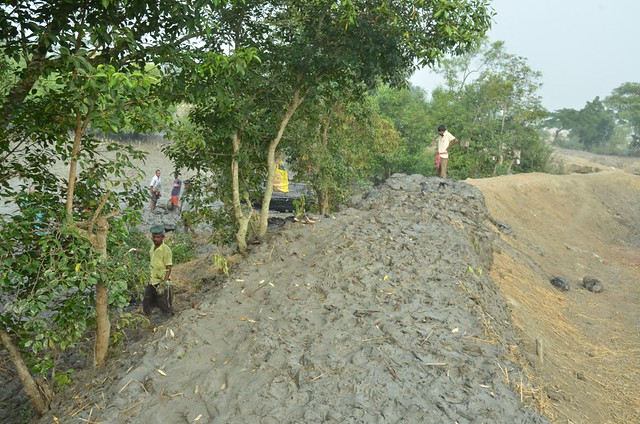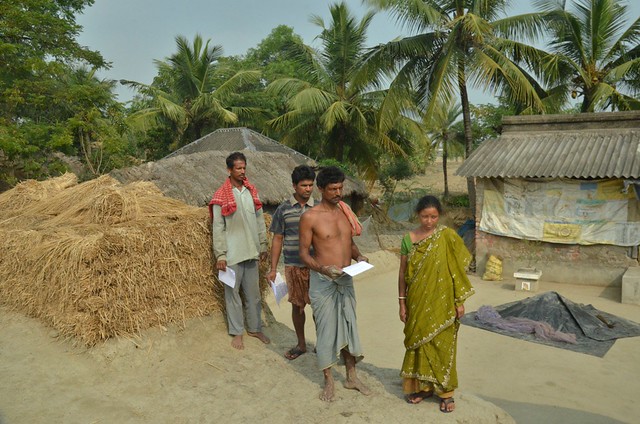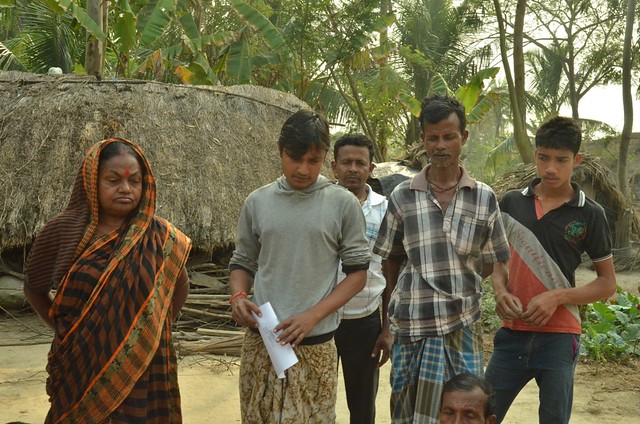In the fourth and final part of the Sunderbans series, we look at the curious case of Hetalbari, a small village in Sunderbans, where the government, at least on paper, acquired land six years ago for an embankment and even paid compensation to some people. The only problem? No work has started, and people continue living on the land for which they were paid compensation. They have no clue when, and where, they will have to move.
By Amit Kumar, Twocircles.net
Sunderbans: For the residents of Hetalbari, the mere mention of Cyclone Aila brings back painful memories. The whole of Sunderbans suffered heavy damages during the cyclones and it was no different for the 2,000 people of this village. The embankment which was supposed to protect them was ripped apart in a matter of minutes, and the whole village remained under water for at least two weeks. “We had to climb trees to save our lives,” says a resident.
In the wake of Aila, a decision was taken by the authorities: in order to avoid any such future encroachments, the government decided to build a 300-feet long concrete embankment in 2010. For the same, it decided to acquire land from the locals.
Whether it is a smart move to make a concrete embankment in such an ecologically fragile area is an important question, especially when similar structures have been decimated in the past by the river current. But for the locals, this seemed a no-brainer. Of course, it had to be built. More than 20 families had lost all their belongings in the Cyclone, and the rest were at the mercy of the nature. So, in 2010, the first announcement regarding the embankment was made, and locals were told that their land would be acquired and they would be suitably compensated.

Unlike most stories regarding land acquisition, the government had a cakewalk here: almost all the 150 families which would lose some, or even all of their land, agreed to the construction and happily offered their land to the government.
So far, so good
Sample this: in 2010, a civil officer from Alipore came to the village, asked people to show how much they own, in what area, and in what form (Agricultural land, pond, house, etc) and noted everything diligently.
And then, no one saw him ever again.
By 2011, there had been zero work on ground regarding the embankment. Nothing changed much for the next two years too.
The locals had got confused: if they were supposed to leave their land, what was the point of trying to grow something on it? Or, why bother making improvements to the house, since they were supposed to lose it. Except, no one knew exactly when they will lose their land.
However, in January 2014, the tide turned, or so it seemed. The collector of Aila Division visited the village and took further details of the land. Subsequently, the first few lucky families also saw the compensation money, or at least a part of it.
But if they thought the deal was done, little did they know that their ordeal had just begun.
People who were given initial cheques of Rs 40,000-70,000 never received another cheque. Some, like Sambhu Mandal, received all of their compensation money in one go: although he denied receiving any money and instead told us that he too had been wronged, the villagers claimed that he had actually received Rs 10 lakh.

This, according to Ashok Mandal, a resident of Chotto Molla Khali, was one of the biggest issues with the acquisition process. Almost all of the 150 families, bar a few, had received some form of compensation, but again, except a few, no one got what they were promised. “When you will take away our land, you will take all of it. Then, how can you compensate only for the area under the house, and not the agricultural land?” asked Nitish Mandal, a resident who had received Rs 70,000. He claims that he was promised Rs 6 lakh for his share of land.
Compensation money transferred to wrong accounts
The other major issue had been the wrong crediting of money, according to locals. “The money I was supposed to get was sent to my brother’s account. Thankfully, since it was my brother it was not an issue. However, two families are still debating over Rs 10,000, where one party claims the money was theirs which went to the other party’s account,” says Sudhir Baidya, a resident of the village.
Gram Sarpanch Subhashini Mirdha, who is now in her final year as the Sarpanch, had been a witnessed to this confusion for years now. “Even I said yes to the embankment, and I will also lose all my land,” she added. She also claimed to have received no money. But she pointed a few more pertinent points. “Even if they did pay some money, it was nearly two years ago and no action has happened on the ground. Most of the people have even spent their money. If they had received the full amount, at least they could have done something about moving. As of now, they continue living in the same place, and have finished their money too. What if they do not get any more compensation and are kicked out tomorrow? Where will they go,” she asked.

None of the compensation packages and the conversation around it seemed to interest Jitendra Kumar Mandal and his two brothers: the trio had been the unluckiest and felt most wronged by the acquisition. The three had been given a combined cheque of Rs 840. “If I had gone to encash it, I would have come back with Rs 700 after factoring in the transport cost,” said Jitendra Kumar. “And this too was two years ago. What use do we have of it now?”
Rehabilitation remains a question no one has an answer to
The far bigger problem for the villagers is not the compensation package: remember, these are islands where population is already high and there is little fallow land left, if any. “We have no clue where we will go. Even people who saved some money from compensation package are finding it difficult to find land to live and run a house, says Suhashini Mirdha.
“All the houses are made of mud, but despite that, all of them have a small pond in front of their homes which supplies them with a fresh dose of fish every day,” she said. “Once this is gone, we do not know where, or how, to settle 150 families on this island itself,” she said.
“If the authorities had started work on time, most families would have started working towards finding other places to move and hopefully, over time they would have settled in this village or the nearby villages. If they now try moving all families at once, the situation will get very difficult for us,” she adds.
For the 150 or so families, the wait for a final decision has entered the sixth year. In between, the temporary embankment has broken twice, and mended by locals. The residents, meanwhile, wonder what will be the final price that they will have to pay when, and if, the work on the embankment begins.
All Photos by Amit Kumar

